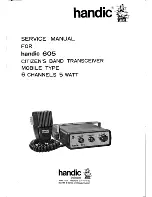
TS-590S
5
Frequency Confi guration
Figure 1 shows the frequency confi guration of this trans-
ceiver.
While transmitting, FM mode operates in a double con-
version and other modes (AM, SSB, CW, FSK) operate in a
triple conversion.
While receiving, the fi rst IF operates in 73.095MHz triple
conversion. In modes other than FM, the third IF is 24kHz,
and the IF signal is converted by an A/D converter and input
CIRCUIT DESCRIPTION
into DSP. The FM mode is detected in the FM IC, and the
audio signal is converted by an A/D converter and input into
the DSP. Under the following conditions, the fi rst IF oper-
ates its reception in 11.374MHz double conversion.
1) Modes other than AM or FM
2) Amateur band within the 1.8/3.5/7/14/21MHz bands
3) DSP fi lter’s bandwidth is 2.7kHz or lower
Fig. 1 Frequency confi guration
PLL
AD4111
DDS
AD9951
DDS
AD9835
11.374MHz
1st IF
73.095MHz
1st IF
ADC
DAC
DAC
ADC
DSP
10.695MHz
2nd IF
3rd IF
IFA
IFB
VCO
FM MOD
RX MIX
RX MIX
TX MIX
x2
except
FM
RX MIX
TX
MIX
455kHz
FM IC
NJM2591
FM
TX/RX
MIX
x2
x2
X502
15.6MHz
AF
24kHz
24kHz
AF OUT
MIC IN
ANT
RX-2
RX-1
Reference Signal Generator
The reference frequency (fstd), which is used to control
the individual LO frequencies, oscillates at 15.6MHz in a
crystal oscillation circuit (X502, Q501). This 15.6MHz signal
passes through a buffer (Q502) and is doubled in a multiplier
(Q503) to generate a 31.2MHz signal. The 31.2MHz signal is
used as a reference signal for LO3 (the third local oscillator)
DDS (IC601). The 31.2MHz signal is doubled in multipliers
(Q504, Q505) to generate a 62.4MHz signal. The 62.4MHz
signal is used as a reference signal for LO1 (the fi rst local
oscillator) PLL (IC801).
The SO-3 (TCXO unit: 15.6MHz) is confi gured as an op-
tion in this transceiver, so that you can replace the crystal
oscillation circuit (X502, Q501) with the SO-3. When using
the SO-3, remove the CN903 and CN904 short jumper wires
in order to stop the operation of the crystal oscillation circuit
(X502, Q501).
LO1/ LO2/ LO3
■
LO1 (the fi rst local oscillator)
The VCO (Q806) oscillates at 196.8MHz. Only the double
frequency component, 393.6MHz, of this VCO’s oscilla-
tion output is extracted and input into PLL (IC801) pin 6.
This input signal is divided into 1/N within the PLL. Also,
the 62.4MHz signal (15.6MHz reference frequency x 4) is
input into PLL pin 8 and divided into 1/R within the PLL. By
a phase comparator in the PLL, the frequency divided into
1/N and the frequency divided into 1/R are compared, and
then the frequency is locked. The comparison frequency (fø)
at this time is 120kHz when transmitting FM, and 2.4MHz
otherwise.
393.6MHz signal locked by PLL (IC801) would be used
as reference by DDS (IC803). The output signal from DDS
(IC803) is 12.495MHz to 32.195MHz when RX-1 path is
selected, amplified at the broad band amplifier (IC804),
Summary of Contents for TS-590S
Page 143: ...TS 590S 143 MEMO ...






































